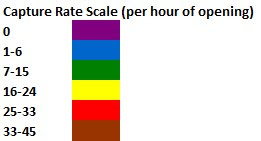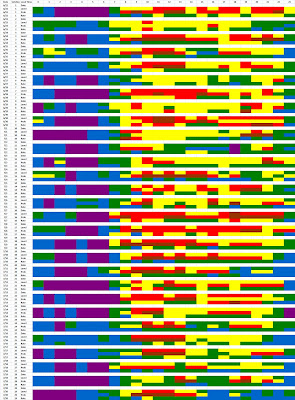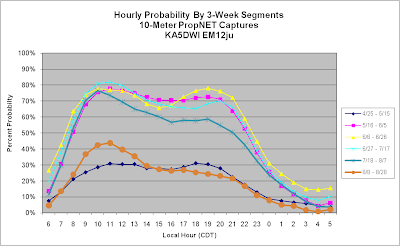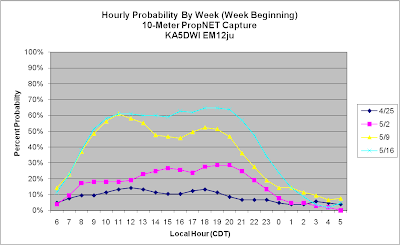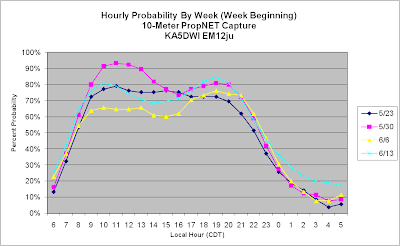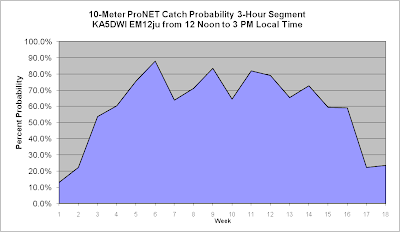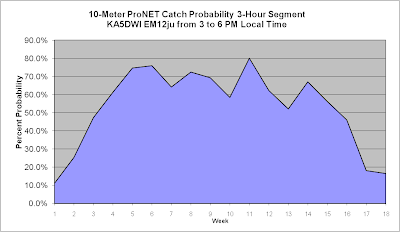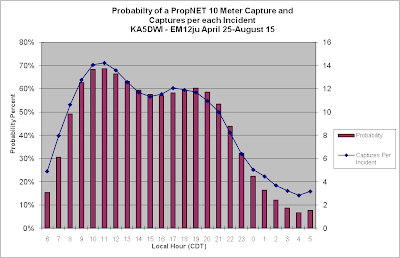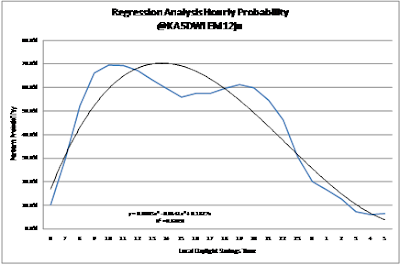“Is Es propagation truly a seasonal occurrence?”
The answer derived from this study is definitely yes. The season begins within days of April 25 and progressively increases up to May 6, at which time it is in full swing and remains totally active until at least August 15. There is still a good chance that activity continues till the end of August. From the study, the season begins 8 weeks prior to the Summer Solstice and ends around 10 weeks after it.
“Since it has been determined to be seasonal, is activity evenly distributed around the Summer Solstice?”
After three years, I thought it was not. But now after 5 years I believe it is. The best part of the Es season is concentrated in the first half (8 weeks long) in a 4-week segment and one should make as much effort as one can during that period. Es are great from the 3rd week through the 6th week (May 9 – June 5). It might calm down slightly for the next four weeks around the solstice, but it in no way does it mean that the season is over. It is still very active during that lull. Once we arrive at Independence Day (July 4th), the season picks up again and it is not until around August 1 that a real decline is noticed. The season does not actually end until sometimes between August 15 and September 1. Statistically and graphically it has a slight right-skewed distribution of opportunities, still the median points of captures and opportunities rested near the Summer Solstice.
“It appears that one works most of their QSOs during the afternoon and evening hours. Is this the best time to work Es?”
No it is not. It appears this way only because most Hams are active late in the afternoon and evenings. The absolute best hours are from after sunrise till the actual Solar Noon hour. On weekends and days off from work, make every effort during the season to work Es during these hours. The late afternoon hours are also very good, distances covered are also better, but opportunities decline once the sun has set. Es are mostly diurnal (daytime phenomena). Es do occur in the late evening and early morning hours. When they do, it is a very special event. Enjoy it and make use of the opening.
“Do Es favor specific directions at certain times?”
Yes it does, and it has to do with the location of the sun. It appears that you follow the sun in order to apply where it is best. As the sun rises, the best conditions tend to be towards the North and East. Gradually, as the sun is high over the horizon, southern paths improve. Once the sun has moved beyond Solar Noon, western paths become better than eastern ones. Therefore, the tendency is that openings appear in the east and north first and then will develop towards the south and the west later on. The process starts over again in the afternoon as was displayed in the dual peak diurnal. Once the sun is setting, northern and western paths will decline in activity at a slower rate while southerly and easterly ones may drop off quickly.
“Can one predict when it is the best time to work real DX locations on Es?”
Yes…..
1. If the DX location is primarily east of you… Concentrate your efforts towards the DX station as your Sun has risen and then once again as the Sun’s Grey Line approaches the eastern DX locale.
2. If the DX location is west of you …Concentrate your efforts towards the western DX station as their Sun rises and then once again as your Sun sets.
3. For Northern and Southern DX paths ….Concentrate your efforts along the suns Grey Line as it leaves or approaches both locations.
This approach appears to produce better results.
“Do severe weather systems and the Jet Stream have any affects on Es propagation?”
Predominately it is small to absolutely none.
A weather system may influence Es propagation between two specific points (experienced here a few times), but I found it difficult to correlate its influence over the entire creation of the phenomena. This study covered 560 days of the Spring and Summer season, over a 5-year period. Of the entire seasonal total, I could only determine that an extremely small percentage of PropNET captures had anything to do with weather systems. In these 5 years, 2 of them were drought years with very little jet stream wind flow and little electrically active weather to speak of. If weather was the primary influence, the hourly charts would have represented trends indicative to weather affects. They clearly failed to do so. For three of the four years of the study, the morning daylight period was clearly the best times for Es propagation. Severe weather is a late afternoon, early evening occurrence. Captures in all four years never displayed the highest activity in the afternoon. In addition, Es would have also occurred at high levels in many other times of the season with varying levels. The study does not show that as is shown by its clear absence of captures in early April.
“Are there any other possible external influences that might affect Es?”
Probably meteors increase the probability of Es.
These were the actual daily captures of record for the 5 years of the study.

This is the potential meteor shower rates per hour for each day during the Es season.
 Source: DL5BAC’s The Meteor Scatter Predictor Program (TMSP)
Source: DL5BAC’s The Meteor Scatter Predictor Program (TMSP)It was not perfect for all peaks of meteor activity, but many of the spikes in captures during the 5 years coincide along them. Meteor influence was brought to my attention at the end of the season when there was an increase in Es activity on July 29-30, August 2 and August 13-14 when one would think that activity should have been very limited.
“What might cause the overall lull in activity and probability during the weeks around the Summer Solstice?”
The high angle of the Sun during this period might have an affect on Mid-Latitude Es. The Nighttime probabilities actually peak during the solstice, therefore it points towards the peak during this period. Maybe the heat radiated off the earth, in addition to the high sun angle deters ionization of the Es layer to some extent. The final two years were minimum solar activity years. The lull was much less pronounced during this time.
“Is the term “Sporadic” a proper identification of the Es propagation phenomena?”
Absolutely not.
The Houghton Mifflin Dictionary defines “Sporadic” as:
1. Occurring at irregular intervals; having no pattern or order in time.
2. Appearing singly or at widely scattered localities, as a plant or disease.
3. Isolated; unique: a sporadic example
The 5 years of the study and the resulting charts show that Es display no such conditions of being Sporadic.
Therefore, we should use the opposite term, “Periodic”.
“Periodic” is defined as:
1. Having or marked by repeated cycles.
2. Happening or appearing at regular intervals.
3. Recurring or reappearing from time to time; intermittent.
Periodic appears to be a much better adjective used to describe Spring/Summer Es propagation.
Future Plans:
I encourage that someone in a different location than mine participate in PropNET each Es season. Efforts to improve data collection from the database created by LiveX will make it much easier to produce statistical analysis for more than one PropNET participant and I will look into this investigation in future years as long as there are an adequate number of participants.
I would like to see the research expanded to 6 and 2-Meters. I am sure we would see similar results experienced between 10 and 6-Meters. PropNET 2-Meter activity would produce a much more worthwhile propagation database than what APRS could accomplish. High population of users and the FM mode in APRS mask many of the propagation conditions that occur on VHF. PropNET could be more valuable than CW beacons.
I plan to list on a website a “Daily Probability” of Es conditions. I hope to have someone (or myself) to write a script very soon for general Ham Radio use that displays in date and time, the probability in percentage of experiencing an Es QSO on 10 Meters along with favorable directional data.
Glossary:
Afternoon Active - Most occur in the afternoon daylight hours.
Morning Active – Most occur in the morning daylight hours.
Averaging Data – It was used to smooth out peaks and lulls between actual days and better concentrate data gathered for hourly statistics. Solar Indices are displayed in running averages. It did not change the actual totals if the data displayed was accumulated.
Coefficient of Determination (R squared)- Is a measure used in statistics that indicates how well a calculated regression trend line approximates the actual data points. The scale is measured from 0.0 to 1.00. 1 reflects a perfect correlation.
Diurnal - Webster’s Dictionary defines this term as:
Recurring every day, occurring in the daytime, or opening during the day and closing at night.
Dual Peaked Diurnal – Two peaks of activity occur in the daylight hours.
Es Propagation – The bending of radio waves in the ionosphere at frequencies from approximately 10 – 230 MHz (25-50 MHz most common) by what is known as the E-Layer of the ionosphere (50-80 miles). Due to its lack of its predictability, it is often referred to as “Sporadic Es”. It is also known as “Short-Skip” because it propagates at shorter distances than normal F2 layer propagation at high frequencies.
Median – American Heritage Dictionary defines this term as:
Relating to, located in, or extending towards the middle
Probability Analysis – Based on the premise that one event occurs for a given time period. In the study, a single capture in an hour would have the same value at 100.
Right Skewed – Statistics term used to describe charted data. If most of the data volume is located to the left of center, it is considered right-skewed.
Right Tailed - Statistics term used to describe charted data. If the chartered data declines at a slower rate and time than it first rises, it is considered right tailed.
SE-Prop – DOS and Windows program developed by Jim Roop - K9SE that displays probable E-Cloud location and MUF between two stations.
Summer Solstice – It is the day that the Sun is directly over the Tropic of Cancer (approximately 23.5° North latitude). It is the highest elevation that the Sun will appear in the Northern Hemisphere. It marks the Winter Solstice in the Southern Hemisphere. When the same condition occurs in the Southern Hemisphere over the Tropic of Capricorn (approximately 23.5° South latitude), it is the Summer Solstice for the southern hemisphere and the Winter Solstice for the northern hemisphere.
Solar Noon Hour – The actual time (hour measured) that the Sun is due south. During Central Daylight Time it occurs at 13:18 or 1:18 PM.
Digisonde – A device that measures the values of returned high frequency radio signals transmitted and received in order to determine ionospheric layer altitudes. The University of Massachusetts Lowell Millstone Hill Digisonde is best known.
W6ELProp – Windows computer program developed by Sheldon C. Shallon, W6EL used for predicting ionospheric (sky-wave) propagation between any two locations on the earth on frequencies between 3 and 30 MHz. Earlier DOS versions were known as MINIPROP and MINIPROP Plus.
A Never-Ending Thank You to the PropNET Organization……..
Top 50 PropNET
Rank-Call-Grid Square-Captures
1 WD4RBX EM84NN 8713
2 WB8ILI EN82OQ 5933
3 K4RKM EM85VF 5160
4 W4JKL EM84AK 5026
5 K8VGL EM69UT 4752
6 AD4RX EL88OD 4443
7 KD5LWU DM57RI 2857
8 N7YG DM42NF 2655
9 K4EPS EL86UW 1752
10 NZ9Z EN64BD 1716
11 N4LR EM73QN 1626
12 KC9MEG EN52TI 1358
13 N4PSN EM84KP 1245
14 KI4EIZ EM63KN 1072
15 KI0GU EN35HF 974
16 WN4AMO EL98CW 861
17 KF6XA DM13JO 827
18 N8QLT EN82HL 707
19 KC6QJO DM05KH 701
20 N0OBG EM48RO 659
21 KC0EFC EM28OX 649
22 W3GYK EM85VF 620
23 WN3C FM19QC 539
24 W2EV FN03XD 529
25 AB0TJ DN60CN 514
26 WB8SKP EM56WR 509
27 WB4U EM94QU 493
28 W3NRG DM12JQ 491
29 NI5F EM42UF 459
30 K5BTV EM74WG 376
31 KF9KV EN52ET 374
32 W6CGH DM13BR 347
33 WA0JYF EN42EB 333
34 WB8SKP EN66TD 326
35 WB4JFI EM92XU 314
36 KC0TLN EM28QX 306
37 WV5L DM65PG 275
38 AB9MS EN42XN 268
39 KD5CFB EM40IQ 221
40 AI4NV EL87PX 192
41 K1HOP FN31SS 191
42 W4DDR EM85BW 177
43 NM4V FM06NR 176
44 NH7O BL10WP 162
45 NK8Q FN20GN 153
46 N5XYO DM90QQ 145
47 WD4ELG FM06LA 139
48 N2JR FM18CO 137
49 K3OMG EN82EI 126
50 W7IXZ DN05XJ 122
73s Art Jackson KA5DWI

